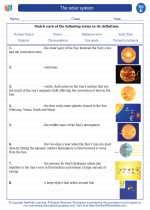Mercury
- Distance from the Sun: 57.9 million km
- Surface Temperature: Ranges from -173°C to 427°C
- Surface Features: Heavily cratered surface, with some plains and ridges
- Atmosphere: Very thin atmosphere composed of trace amounts of gases
Venus
- Distance from the Sun: 108.2 million km
- Surface Temperature: A scorching 462°C, making it the hottest planet in the solar system
- Surface Features: Volcanoes, vast highland regions, and plains
- Atmosphere: Thick and toxic atmosphere primarily composed of carbon dioxide
Earth
- Distance from the Sun: 149.6 million km
- Surface Temperature: Ranges from -88°C to 58°C
- Surface Features: Diverse landscapes including mountains, oceans, and continents
- Atmosphere: Nitrogen-rich atmosphere with oxygen, suitable for supporting life
Mars
- Distance from the Sun: 227.9 million km
- Surface Temperature: Ranges from -87°C to -5°C
- Surface Features: Large volcanoes, canyons, and polar ice caps
- Atmosphere: Thin atmosphere primarily composed of carbon dioxide
Characteristics of Terrestrial Planets
1. Describe the composition and structure of terrestrial planets.
2. Compare and contrast the surface features of Mercury, Venus, Earth, and Mars.
3. Analyze the atmospheres of terrestrial planets and their implications for habitability.
4. Explain the distance of each terrestrial planet from the Sun and its impact on surface temperatures.
Comparison with Gas Giants
1. Differentiate between terrestrial planets and gas giants in terms of composition and structure.
2. Discuss the presence of atmospheres and its significance for terrestrial planets versus gas giants.
3. Compare the distance of terrestrial planets and gas giants from the Sun and its influence on their characteristics.
Potential for Life
1. Evaluate the potential for life on terrestrial planets based on their surface features and atmospheres.
2. Discuss the significance of Earth's atmosphere and surface conditions for supporting life compared to other terrestrial planets.
3. Formulate hypotheses about the possibility of past or present life on other terrestrial planets based on available data.
.◂Science Worksheets and Study Guides Fifth Grade. The solar system

 Worksheet/Answer key
Worksheet/Answer key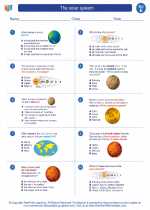
 Worksheet/Answer key
Worksheet/Answer key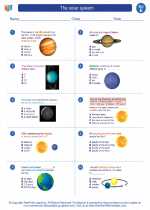
 Worksheet/Answer key
Worksheet/Answer key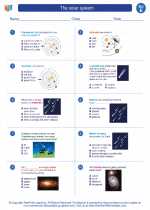
 Vocabulary/Answer key
Vocabulary/Answer key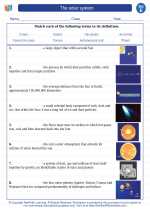
 Vocabulary/Answer key
Vocabulary/Answer key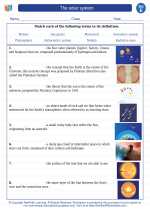
 Vocabulary/Answer key
Vocabulary/Answer key